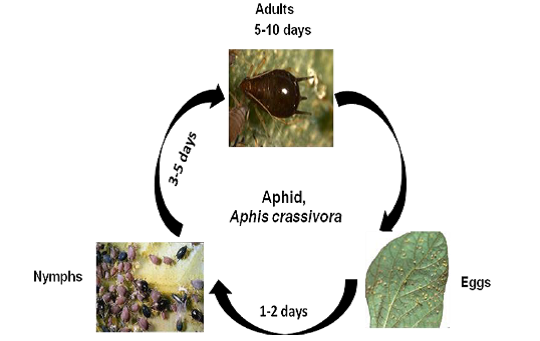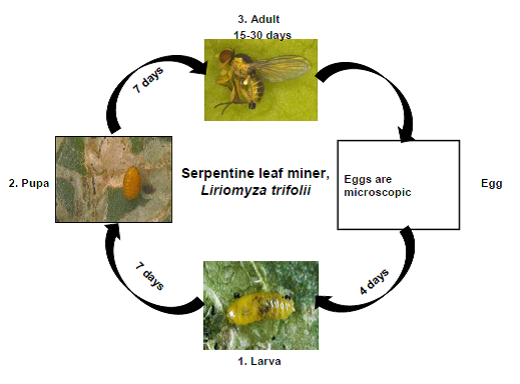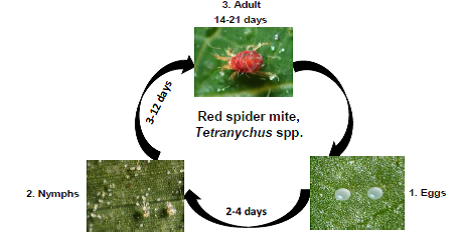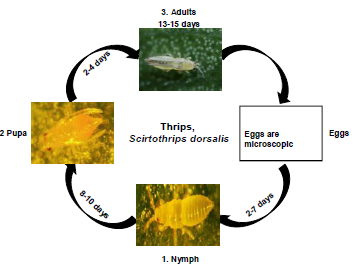Fenugreek Insect Pests
Fenugreek Insect Pests
Aphid
Biology:
- Egg: Eggs are very tiny, shiny-black, and are found in the crevices of bud and stems, of the plant, especially in colder regions of the world and may overwinter as eggs. In warmer parts of the world aphids usually do not lay eggs and parthenogenic reproduction takes place throughout the year.
- Nymph: Nymph (immature stages) are young aphids, they look like the wingless adults but are smaller. They become adults within 7 to 10 days.
- Adult: Adults are small, back to dark brownish colour, 1 to 4 mm long, soft-bodied insects with two long antennae that resemble horns. Most aphids have two short cornicles (horns) towards the rear of the body. A female aphid lives for 9 to 25 days and can produce from 25 to 125 young during its life. There may be up to twenty generations in the year.
Life cycle:

Damage symptoms:
- Nymphs and adult aphids suck plant sap from leaves, shoots, buds and floret.
- In addition, plants may become contaminated by honeydew produced by aphids and sooty mould growing on honeydew.
- Fenugreek contaminated with honeydew and / or sooty mould are not marketable.
- Aphids are also vectors of diseases, including the common bean mosaic virus.
- The black bean aphid is a widely distributed pest of fenugreek.
Natural enemies of aphid:
- Parasitoids: Aphidius colemani, Aphelinus sp, Diaeretiella sp
- Predators: Red ant, Big-eyed bug (Geocoris sp), Earwig, Cecidomyiid fly, Dragon fly, Lacewing, Ladybird beetles, Syrphid flies, etc.
Leaf Miner
Biology:
- Egg: Minute orange yellow, apodous maggot feeds on chlorophyll mining in between epidermal layers.
- Larva: Full grown maggot measures 3 mm. Larval duration is about 7 days. Pupation is in soil. Some pupae are found in leaves. Total life cycle takes 3 weeks.
- Pupa: Pupation takes place inside a thin loose mesh of silken cocoon. Pupal period is about 7 days.
- Adult: It is a pale yellowish fly, measuring 1.5 mm in length. The female fly punctures upper surface of leaf to lay eggs singly. The egg hatches in 4 days. Serpentine leaf miner is polyphagous pest, native of Florida (USA) and believed to be accidentally introduced into India. It is widely distributed in Andhra Pradesh, Tamil Nadu, Karnataka, Maharashtra causing damage to fibre crops, pulses, ornamentals, vegetables, fodder etc. It is a serious pest on cucurbits, cotton, ridge gourd, brinjal, and potato.
Life cycle:

Damage symptoms:
- Leaves with serpentine mines. The maggot punctures the epidermal layers and scraps the chlorophyll content between the layers. In severe cases, the photosynthetic activity is reduced and leads to death of the plant.
- In severe cases, defoliation occurs.
Favourable conditions:
- Warm weather conditions are favourable for multiplication.
Natural enemies of leaf miner:
Parasitoids: Gronotoma micromorpha (larva and pupa), Diglyphus sp (larva), Halticoptera circulus and Opius sp (pupal), Chrysocharis sp, Neochrysocharis formosa (Westwood).
Mites
Biology:
- Egg: Gravid females lay reddish, hyaline, spherical eggs in mass on undersurface of leaf. Eggs hatch in 2-5 days.
- Nymph: After hatching neonates are light brown in colour with three pairs of legs. After feeding underneath the leaf in webs, larvae become nymphs with four pairs of legs. Developmental stages include six-legged larva. Protonymph and deutonymph.
- Adult: Adults are red coloured, smaller in size. Females are oval, pyriformin shape, bright crimson anterior and dark purplish brown posterior. Mites spin a web of silken threads undersurface of leaf. Total life cycle is completed in 10-18 days depending upon the environmental conditions.
Life cycle:

Damage symptoms:
- Spider mites usually extract the cell contents from the leaves using their long, needlelike mouthparts.
- This results in reduced chlorophyll content in the leaves, leading to the formation of white or yellow specs on the leaves. In severe infestations, leaves dessicate and drop off.
- The mites also produce webbing on the leaf surfaces in severe conditions. Under high population densities, the mites move to using strands of silk to form a ball-like mass, which will be blown by winds to new leaves or plants, in a process known as “ballooning.”
Natural enemies of red spider mites:
Predators: Anthocorid bugs (Orius spp.), mirid bugs, syrphid/hover flies, lacewings (Mallada basalis and Chrysoperla carnea), predatory mites (Amblyseius alstoniae, A. womersleyi, A. fallacies and Phytoseiulus persimilis), predatory coccinellids (Stethorus punctillum), staphylinid beetle (Oligota spp.), cecidomyiid fly (Anthrocnodax occidentalis), midge (Feltiella minuta) etc.
Entomopathogen: Beauveria bassiana
Thrips
Biology:
- Egg: Eggs are hyaline, globular laid in mass inside the leaf tissues of leaves and shoots.
- Nymph: Nymphs are tiny, slender, fragile and straw yellow in colour.
- Adult: Adults are slender, yellowish brown with heavily fringed wings. There are several overlapping generations in a year.
Life cycle:

Damage symptoms:
- The infested leaves curl upward, crumble and shed
- Infested buds become brittle and drop down.
- Affected fruits show light brown scars
- Early stage, infestation leads to stunted growth and flower production, fruit set are arrested
Host-range and favourable conditions:
- S. dorsalis is found in almost all chilly growing areas.. Besides chilli, it also infests brinjal, cotton, groundnut, castor, bottle gourd, guava, tea and grapevine. It is more common on unirrigated chilli crop than irrigated one.
Natural enemies of thrips:
Predators: Predatory mite, predatory thrips, Oligota spp., Orius spp. (pirate bug), hover flies, mirid bug etc.,
Spotted pod borer
Biology
- Egg: Eggs of the moth are pale cream and flattened.
- Larva: Larvae are pale cream with two rows of distinctive paired black markings on their back. In the final instar, these markings are often very pale. Larvae can reach 18 mm in length.
- Pupa: Pupa elongated and reddish brown in colour.
- Adult: Adults have a 20-25 mm wingspan and a slender body. They have brown forewings with a white band extending two-thirds down the wing from the leading edge. Inside this band near the leading edge is a white spot. The hindwings are predominantly a translucent white with an irregular brown border. When at rest, they adopt a characteristic pose with outspread wings and the front of the body raised.
Damage symptoms:
- Seeds within damaged pods are totally or partially eaten out by bean pod borer larvae. Entry holes also let in water, which stains the remaining non-eaten seeds.
- Fenugreek pod borer larvae may web young leaves together and may tunnel in plant stems. Such damage is not typical of its behaviour on other legumes.
Natural enemies of mung moth:
- Parasitoids: Trichogramma sp., Bracon sp., Apanteles taragamae, Carcellia etc.
- Predators: Spider, red ant, reduviid bugs, praying mantids
IPM for Fenugreek
To know the IPM practices for Fenugreek, click here.
Source: NIPHM and Directorate of Plant Protection, Quarantine & Storage
Last Modified : 3/30/2020
This topic covers information about Pea Insect Pes...
This topic covers information about Ber Insect and...
This topic covers the information related to Insec...
This topic covers information about Amla Insect Pe...
